1. Discovery of the Topeng (Indonesian word for mask)
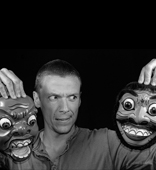 After several trips to Indonesia, and an extraordinary encounter with Indonesian masks, Stanislas Dorange developed a passion for these endangered popular culture objects.
After several trips to Indonesia, and an extraordinary encounter with Indonesian masks, Stanislas Dorange developed a passion for these endangered popular culture objects.
This encounter had him crossing Java by train, going from one village to another, looking for sculptors and dance artists to better understand this mask dance theatre tradition.
From there he moved to Bali, Madura, and Lombok. All of these islands revealed there own cultural and artistic traditions linked by the same religious roots.
It realm of spirits and forces that most often point out the opposition between good and evil, in which the characters antics and satire have an important role.
This realm is embodied by the many kinds of exquisite coloured masks that deserve to be better known and exposed to the world.
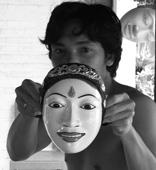
Even if the Topeng (Indonesian word for mask) is not famous in the West, its power and its style as often compared in the preface of specialised books, to masks of the Japonese Theatre No which is considered as the reference in the field of mask theatre.
This is why the Javanese and Balinese ‘s Rajah (monarch) have been collecting the Topeng for generations.
2. Role and kinds of the Topeng
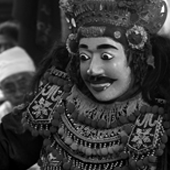 The Topeng holds a very important role in Indonesia. In Bali for example, it is used to regulate social life during religious ceremonies in the temple (where they are displayed at the alter and fed) or for theatrical representations.
The Topeng holds a very important role in Indonesia. In Bali for example, it is used to regulate social life during religious ceremonies in the temple (where they are displayed at the alter and fed) or for theatrical representations.
The Topeng is also sometimes used for villages’ processions to bless houses and protect the harvest during occasions such as weddings and births or sometimes just to entertain.
The Topeng are kept in the temples and used for the processions and are considered powerful and sometimes even dangerous. They are given very special treatment. : blessings are given and prayers repeated before taking them out of the temple which is done very carefully in a special wicker case.
The masks are regularly fed with different offerings to assure their protective favours, (Barong Ket ‘the king of the forest',) or to avoid their anger, (Dewi Durga), or even to help them fall back asleep (Kumbakarma who wakes up periodically starving hungry).
On the other hand the Topeng used in theatres only get their importance when they are worn by an actor. However the main character’s masks (like Rama, Sita) or religious ones (Sidakaria, Pedanda) are prepared for the theatre with similar rituals (prayers and offerings).
It is important to notice that it is impossible to separate dance from singing and theatre as it is done in Europe. In Indonesia the artistic scene is a mix, a fusion of all these artistic expressions.
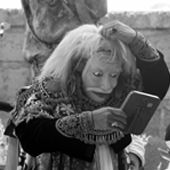
There are three principal shapes of mask: those that recover the entire face, the half-mask (allowing the actor to speak) and the mini masks (used principally for clown characters).
Each Topeng is noticeable first by the features of the character played, but each one also expresses the style of the region where it was sculpted.
Malang, Cirebon, Yogyakarta, Madura, Gianyar are different regions with different styles.
For example some regions create sculpted crown decorated with madurese flowers, painted eyelashes under the eyes slits on the Ciberon’s masks, Sekartaji’s crowns on the Balines’s Topeng, long pointed nose’s on some Javanese masks.
The diversity of the masks is equal to the diversity of the Indonesian artistics scene, with each sculptor providing their own personal touch.
The features of the masks are as important as the colours in the explanation of their role and give precious information about their character (some masks are even repainted in another colour for the need of a play).
Unfortunately even if there are still a couple of ‘big’ sculptor families, this traditional art is tending to disappear.
3. The main character themes in Indonesian masked theatre.
There are six principal character themes of the masks used in Indonesian theatre: heroes, servants, spirits, Barong (a character in Bali’s mythology), animals, and the Bondres.
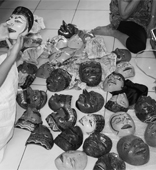 Heroes in Indonesian theatre are most of the time high-ranking people even sometimes priests and their pure and generous heart .Their stories become the Framework of the play.
Heroes in Indonesian theatre are most of the time high-ranking people even sometimes priests and their pure and generous heart .Their stories become the Framework of the play.
These heroes come along with their faithful servants who most of the time become the narrator. After that come two character themes with very powerful masks: the spirits and the Barongs.
The first ones (the spirits) are evil and when they are not trying to attack the heroes, they fight against the second, (the Barongs) the guardians and protectors of the good, in a conclusive fight.
Animals can have various and important roles: from the frog (Kodok) , to he laughing monkey that drives the other characters up the wall, and the famous Hanuman, along with Garuda, the mystical bird from Ramayana.
Finally, there are the Bondres. These are buffoons, caricatures of people designed to divert the public's attention between scenes. Some plays are even dedicated entirely to them.
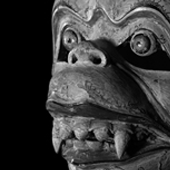 These characters, very important in Indonesian culture, have many similarities to other kinds of masked theatre in Asia and Europe.
These characters, very important in Indonesian culture, have many similarities to other kinds of masked theatre in Asia and Europe.
For example, the Bondres' characteristics and roles are very similar to masks used by buffoons in the Commedia dell’arte.
The Barongs have a similar function to the masks used in Tibetan processions and in Chinese exorcism theatre Nuo. Further, the Balinese heroes’ mask have a role and delicate features close from those in No’s Japanese’s theatre, where some Lombok’s masks show a great similarity with Bugaku theatre mask’s (the former No theatre).
As well, some of the masks with a healing function remind us of those used in Sri Lanka.
4. Theatres
In Indonesia, many kinds of dance and mask theatre are evolving all the time, when they haven’t already disappeared.
Below is a chronological order of mask dance theatre of which some are still performed on the Indonesian archipelago.
- The Gambuh
This theatre which has been performed in the Indonesian royal court for decades is the predecessor of Balinese mask theatre.
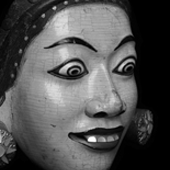 Apparently in 1000 A.D., a company composed of dancers and artists was escorting a Javanese princess visiting the Balinese court and this company offered such an amazing show to the king, that he decided to develop a similar art on his Island.
Apparently in 1000 A.D., a company composed of dancers and artists was escorting a Javanese princess visiting the Balinese court and this company offered such an amazing show to the king, that he decided to develop a similar art on his Island.
This art is now known as Gambuh.
This theatre is the most flamboyant in Balinese history because of its dance characteristics and it’s virtuoso musical arrangement played by the Gamelan.
Gambuh’s principal themes come from Javanese legends and stories, for example recounting Panji’s chronicle
- Barong dances
There are a lot of different Barong dances and each evolves with time. Sometimes these dances disappear or become another kind of theatre.
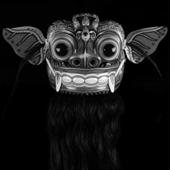 The Calonarang is for example a Barong dance originating from the Gambuh. Many versions of the Calonarang exist but the principal theme is the same: the fight and the balance between good and evil. In one of these versions, Calonarang is a witch, trying to marry her daughter Ratna Menggali to the good King Erlangga.
The Calonarang is for example a Barong dance originating from the Gambuh. Many versions of the Calonarang exist but the principal theme is the same: the fight and the balance between good and evil. In one of these versions, Calonarang is a witch, trying to marry her daughter Ratna Menggali to the good King Erlangga.
The witch becomes angry when she discovers that the people are not in favour of this ill-fated union.
The witch flies into a fury and becomes Rangda, the Evil Goddess. Plague and drought descend upon the island of the King Erlangga.
Soldiers and villagers try to fight her, but she puts a spell on them and they turn their swords on themselves.
The Barong intervened, as he was the only one able to push her away, but only for a while…
Representations of the Calonarang often had to do with the idea of an exorcism and were used most often during periods of plague or starvation
There also exist other kinds of Barong dance which are staged during processions within a village or moving from one village to another.
The purpose of these processions is to signify moments in the Balinese calendar, to protect and bless the inhabitants and their future harvest.
Also it is meant to protect against disease and also celebrate unions and births. The Barong dances have great religious and spiritual importance.
Today they are also performed as a show to entertain tourists. Here are other Barong dances:
- Barong Ngelaway, it stages Barong Ket ;
- Barong Langdang, dance of giant puppets Jero Gede and Jero Luh ;
- Barong Bangkal, mostly danced for New Year’s Day. ;
- Barong Kedingkling, ancestor of the Wayang Wong.
- Wayang Wong
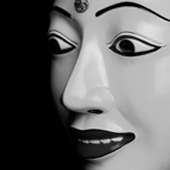 Originally, forty or so actors and dancers performed the Wayang Wong , reenacting Ramaya’s final fight. Half of the group played Rama’s monkey army, fighting against the other half, Ravana’s devoted.
Originally, forty or so actors and dancers performed the Wayang Wong , reenacting Ramaya’s final fight. Half of the group played Rama’s monkey army, fighting against the other half, Ravana’s devoted.
This scenario was known as Barong Kedinkling.
This dance theatre was born under the influence of the royal family of the time. Ramayan masked characters were created for the scene like: Rama, Sita, Laksmana, Ravana, Kumbakarana.
Thanks to that new Ramayana’s stories were told and the Wayan Wong, the “shadow” Wayang and the “man” Wayang, with characteristics directly inspired from the Kulit Wayang (Puppet shadows theatre) was born.
- Topeng
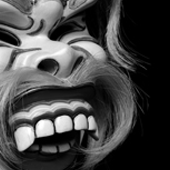 The Topeng means “squeezed against the face” and obviously “mask”. It is also the given name to dance theatre that commemorates the historical events of famous kings, heroes and priests. The Topeng also inspired the Babad literature (old manuscript).
The Topeng means “squeezed against the face” and obviously “mask”. It is also the given name to dance theatre that commemorates the historical events of famous kings, heroes and priests. The Topeng also inspired the Babad literature (old manuscript).
The Topeng helps perpetuate the memories and uphold the morals of upholds the Balinese’s by showing, honestly, the constant evolution of society. There are different shapes of masks:
- The Pajegan Topeng: the oldest shape of Topeng is played by only one actor-dancer, who takes the role of several characters by changing his mask. One of the most important characters in this theatre is called Sida Karya.
- The Panca Topeng that is inspired of the Pajegan Topeng, is played by five actor-dancers.
- The Prembon Topeng is a mix of theatre and feminine dance (like for example the Arja). A couple of actor-dancers are masked while the others are not.
- The Bondres Topeng is a burlesque theatre with caricatures. Most of the time this theatre is improvised. It is a new kind of Topeng theatre.
- The Babakan Topeng is Javanese. This theatre explores the chronicles of Panji.
5. Mask sculpture in Bali
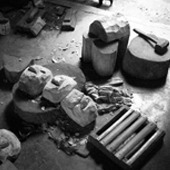 The making of a mask is an art that is told from father to son. Before moulding a mask, it is an obligation to know and understand the purifying ceremonies and the sacred rituals.
The making of a mask is an art that is told from father to son. Before moulding a mask, it is an obligation to know and understand the purifying ceremonies and the sacred rituals.
The masks are sculpted into ‘pule’ wood, but before is is cut a series of offerings are given to the forest and to the tree itself .Then before work on the wood can begin, two more offerings are needed.
The first one is given to Bhatara Surya, the Sun God to witness the work of the sculptor.
The second one is for Taksu, the talent and inspiration’s spirit.
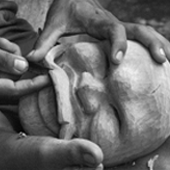 Once the wood is cut, it is brought to the temple and worked there or at the craftsman place according to traditional methods.
Once the wood is cut, it is brought to the temple and worked there or at the craftsman place according to traditional methods.
The ‘pule’s’ wood is a strong wood with few veins and easy to stain. The craftsman works on the block of wood on the ground between his feet using the instruments useful for the different steps of the hewing.
First the work starts with a hatchet to rough-hew the block. The main difficulty here is to get a symmetrical cut, a necessary guarantee of a good quality mask.
As the work progresses the instruments become progressively thinner. The finishing touches are made with a knife.
The knife it used to carve the face’s fine details that will give the mask all its features and characteristics (wrinkles, eyes, nose..).
The back of the mask is hollowed with a curve knife. Many hours sanding are necessary to refine the purest expressions on the mask while also making the mask enjoyable to wear by the dancer once the it is finished.
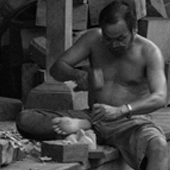 Then comes the staining process, which differs according to the importance of the character played.
Then comes the staining process, which differs according to the importance of the character played.
Traditionally, the paint and the glue are vegetable or organic based. For example, coal is used for black; animal bones can be reduced to powder then boiled to get white, and yellow and red chalks are imported from China.
Other colours come from the mix of basic pigments. However, nowadays some natural colours are almost impossible to find and are replaced by modern paint.
A more vivid red now replaces the ‘oranged’ colour of the Barong Ket.
The last step and the addition (if necessary) of whiskers, eyebrows, hair and ornament come from animal or vegetal sources.
They can be mother of pearl, goatskin, fox, monkey, human hair stones etc…
